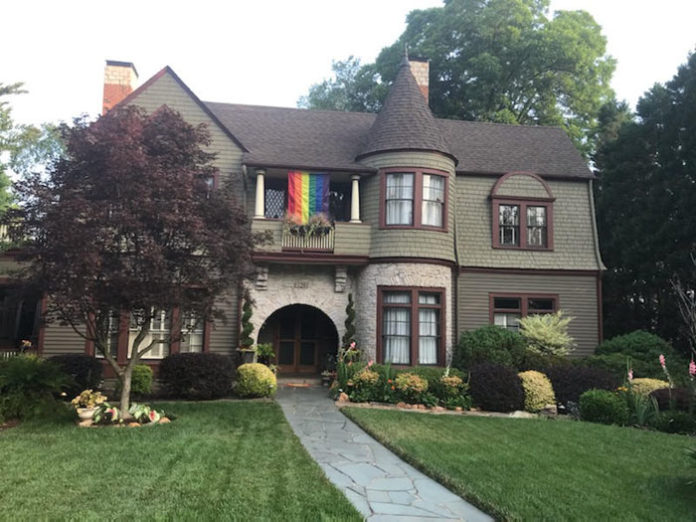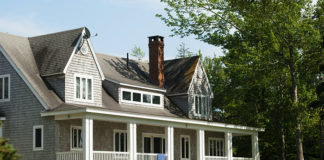
By Pete Prunkl
Historic Salisbury Foundation
SALISBURY — “From its beginning in the 19th century, historic preservation in America has been shaped by gay men,” said Mark Sammons in the book, “A Passion to Preserve: Gay Men as Keepers of the Culture.”
Shaped . . . but not often acknowledged. For Pride month, Historic Salisbury Foundation expresses its appreciation to the gay men of Salisbury for buying, maintaining, furnishing and saving key examples of our historic-built environment.
At least seven historic houses in the West Square Historic District are owned by gay couples or gay individuals. Their houses are some of the largest, oldest, most picturesque and best preserved in Salisbury’s first historic district.
Jon Planovsky and Bob Lambrecht own the Moore House, a Salisbury landmark at 124 South Ellis Street. Since 2007, the couple’s goal has been to restore the 1892 house to the way artist Beulah Moore left it in 1947.
“As long as I can remember I’ve been drawn to craftsmanship, architectural details and good design,” said Jon, a corporate art director in a previous career. For years, Bob hoped to buy his grandmother’s Tudor-style house in South Pasadena, California, and inherit her antique furniture. His design emphasis began as a child when he created floor plans with a long garden hose in the backyard with his sister and cousin. The children then furnished the imaginary house with chairs, lamps and tables from their homes.
The Moore House also provides an emotional connection with the past for Jon and Bob — this is where Miss Beulah painted, where she taught young artists, where she conversed with her colleagues. Part of the motivation for seeking landmark status for the Moore House was to ensure that the architectural details Beulah selected would not be replaced or removed by future generations. All the gay men interviewed for this article expressed a similar connection to history. All have obtained documents and photos relating to their houses and researched the names of former owners and neighboring houses. They know about every change to the windows, stairs, woodwork and porch made by previous owners.
For many of these men, interior and exterior design was a big part of their early lives. During his teen years Matt Beaver, who owns the 1838 Charles Law Torrence House at 428 West Bank Street, watched Matt Flint restore the John Steele House for Ed Clement. He also admired the clean simple lines of the Arts & Crafts house at 315 West Horah where he lived with his mother. “I would watch ‘This Old House’ on television instead of kid shows,” said Adrian Easley, who admitted to a youthful obsession with chandeliers, doodling floor plans and hunting for antiques at Clines in Mount Pleasant. Adrian and his partner Alex Greene bought the John Knox House, Nancy and Bill Stanback’s house at 303 West Bank Street. As youngsters, they each created floor plans with The Sims, a life simulation computer game and built furniture with Legos.
A love of preservation and design did not come early for Frank Labagnara and David Garling, the owners of the Andrew Murphy House at 229 West Bank Street. They both lived in modest houses in their youth. Making ends meet was more important for their families than architecture or period furniture. Their interest in preservation occurred after they met.
Antiques, oil paintings and old houses go together like red wine, brie cheese and French bread. The gay men interviewed for this article collect everything from classic cars and period furniture to 19th century oil paintings and Rembrandt lamps, clocks and pottery. Adrian and Alex, both in their 30s, have more contemporary furnishings than antiques, but period furniture is on their to-do list.
Asked if the urge to preserve sprang from his sexual orientation, Jon Planovsky was not sure. “Not all gay men are preservationists,” he said. “I think a huge part of preservation is double income, no kids. Gay couples have the money to fix up old homes.” Sexual orientation has to do with attraction, not design or preservation,” said Jon. “My orientation is that I like old things. So do many straight people.”
Others found the connection more compelling. “Homosexuals like pretty things,” said Adrian Easley. “We have good taste and are attracted to the grandeur of old houses.” Their neighbor, David Garling reinforced that viewpoint: “Gay people like to decorate. I cannot live with ugly.” “The stereotype is probably true,” added Matt Beaver, who finds that old houses can turn off those with young children because of heating, insurance and maintenance costs.
The road to preservation can be rocky for gay men. When they moved to Salisbury, Jon and Bob were told they should never fly a Pride flag in Salisbury. They not only fly the rainbow flag, but Bob sells them at his store, Critters. In 1980, when David and Frank made an offer on a 1905 house in Cleveland Heights, Ohio, they learned that their Realtor was working against them. “One of our neighbors told me that our Realtor tried to get someone to outbid us so that the neighborhood would remain straight,” said David. “He was having a fit that a gay couple was moving into the neighborhood.”
Things like that were less likely to happen in Washington, D.C., said Matt Beaver, who bought an 1870 town house in our nation’s capital in 2012. “Thankfully there are a lot more laws today preventing discrimination based on orientation and gender identity. For a while, I was a Realtor in D.C., where many Realtors were in the LGBTQ community,” he said.
Discrimination like that experienced by Frank and David belongs to an earlier generation, said Adrian Easley. “When a gay couple moves into a neighborhood, home values go up. They are going to make the house better than they found it.” “Gays are usually a welcome addition to a neighborhood,” added Alex. The heirs to the Stanback estate were happy that a gay couple bought the family home and adopted Mazie and Pretty Boy, the Stanback’s cats. “Bill and Nancy fought for desegregation and gay rights locally and nationally,” said Adrian. “There is probably no better legacy for them than to have a gay couple here.”
David, Frank, Jon, Bob, Matt, Adrian and Alex have one more thing in common. They want their names used in this article. They are justifiably proud of their identity, and the role gays play in preserving American culture. As David said, “I want you to know I am gay and an Episcopalian.” And so much more.








